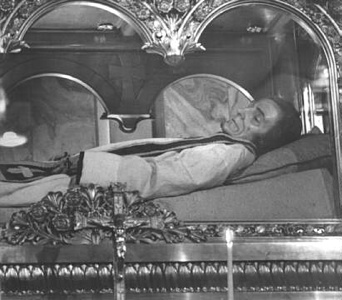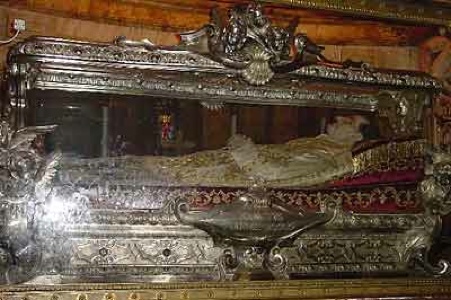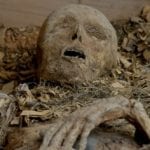 Creepy
Creepy  Creepy
Creepy  Movies and TV
Movies and TV 10 Movies That Get Elite Jobs Right, According to Experts
 Weird Stuff
Weird Stuff 10 Times Real Laws Were Based on Bizarre Hypotheticals
 Animals
Animals 10 Inspiring Tales of Horses Being Human
 Mysteries
Mysteries Top 10 Haunting Facts About the Ghost Ship MV Alta
 History
History 10 Surprising Stories About the Texas Rangers
 Humans
Humans 10 Philosophers Who Were Driven Mad by Their Own Theories
 Miscellaneous
Miscellaneous 10 Video-Game-Worthy Weapons and Armors from History
 Weird Stuff
Weird Stuff 10 Psychics Who Accurately Predicted Wartime Events
 The Arts
The Arts 10 Pieces of Art Inspired by a Broken Heart
 Creepy
Creepy 10 Death Superstitions That Will Give You the Creeps
 Movies and TV
Movies and TV 10 Movies That Get Elite Jobs Right, According to Experts
 Weird Stuff
Weird Stuff 10 Times Real Laws Were Based on Bizarre Hypotheticals
Who's Behind Listverse?

Jamie Frater
Head Editor
Jamie founded Listverse due to an insatiable desire to share fascinating, obscure, and bizarre facts. He has been a guest speaker on numerous national radio and television stations and is a five time published author.
More About Us Animals
Animals 10 Inspiring Tales of Horses Being Human
 Mysteries
Mysteries Top 10 Haunting Facts About the Ghost Ship MV Alta
 History
History 10 Surprising Stories About the Texas Rangers
 Humans
Humans 10 Philosophers Who Were Driven Mad by Their Own Theories
 Miscellaneous
Miscellaneous 10 Video-Game-Worthy Weapons and Armors from History
 Weird Stuff
Weird Stuff 10 Psychics Who Accurately Predicted Wartime Events
 The Arts
The Arts 10 Pieces of Art Inspired by a Broken Heart
Top 10 Incorrupt Corpses
Throughout the years the Roman Catholic Church has found the bodies of some of their saints to be incorrupt. When this happens, the body is often put on display (quite often they are put inside a Church altar with a glass front). This is a list of the most famous incorrupt saints.
See Also: 10 Incredibly Gross Stories About Beloved Saints
10 St Bernadette of Lourdes, Died 1879
St Bernadette was born Bernadette Soubirous in Lourdes, France. From February to July 1858, she reported eighteen apparitions of “a Lady.” Despite initial skepticism from the Roman Catholic Church, these claims were eventually declared to be worthy of belief after a canonical investigation. After her death, Bernadette’s body remained “incorruptible”, and the shrine at Lourdes went on to become a major site for pilgrimage, attracting millions of Catholics each year.
Death is history’s most abundant resource. Satisfy your morbid curiosity with The Black Death (Great Historic Disasters) at Amazon.com!
9 St John Vianney, Died 1859
St. Jean Baptiste Marie Vianney (May 8, 1786 – August 4, 1859) was a French parish priest who became a Catholic saint and the patron saint of parish priests. He is often referred to, even in English, as the “Curé d’Ars” (the parish priest of the village of Ars). He became famous internationally for his priestly and pastoral work in his parish due to the radical spiritual transformation of the community and its surroundings.
8 St Teresa Margaret, Died 1770
n March 19, 1934, Pope Pius XI entered Blessed Teresa Margaret of the Sacred Heart in the register of saints. In Germany, the new saint is virtually unknown outside of the Carmelite Order. Her life was quiet and hidden. She died on March 7, 1770 at the age of 22, and of this short lifespan, she spent five years in the Carmelite monastery in Florence. She performed no brilliant, attention-getting deeds, nor did her reputation reach the wider world. She spent her life living quietly and with virtue.
7 St Vincent de Paul, Died 1660
Saint Vincent de Paul studied humanities at Dax with the Cordeliers and he graduated in theology at Toulouse. Vincent de Paul was ordained in 1600, remaining in Toulouse until he went to Marseille for an inheritance. On his way back from Marseille, he was taken captive by Turkish pirates to Tunis, and sold into slavery. After converting his owner to Christianity, Vincent de Paul was freed in 1607. Vincent returned to France and served as priest in a parish near Paris. n 1705 the Superior-General of the Lazarists requested that the process of his canonization might be instituted. On August 13, 1729, Vincent was declared Blessed by Benedict XIII, and canonized by Clement XII on June 16, 1737. In 1885 Leo XIII gave him as patron to the Sisters of Charity.
6 St Silvan, Died Circa 350
There is little known about Saint Silvan except that he was martyred (killed for his faith). Considering his body is over 1,600 years old, it is remarkably preserved.
Surprised by some of these? Read up on Catholicisms bizarre traditions with Signs of Life: 40 Catholic Customs and Their Biblical Roots at Amazon.com!
5 St Veronica Giuliani, Died 1727
Saint Veronica Giuliani (Veronica de Julianis) (1660-July 9, 1727) was an Italian mystic. She was born at Mercatello in the Duchy of Urbino. Her parents, Francesco Giuliana and Benedetta Mancini, were both of gentle birth. In baptism she was named Ursula. According to the Catholic Encyclopedia, she showed signs of sanctity from an early age. Her legend states that she was only eighteen months old, she uttered her first words to upbraid a shopman who was serving a false measure of oil, saying distinctly: “Do justice, God sees you.”
4 St Zita, Died 1272
Saint Zita (c. 1212 – 27 April 1272) is the patron saint of maids and domestic servants. She is also appealed to in order to help find lost keys. Zita often said to others that devotion is false if slothful. She considered her work as an employment assigned her by God, and as part of her penance, and obeyed her master and mistress in all things as being placed over her by God. She always rose several hours before the rest of the family and employed in prayer a considerable part of the time which others gave to sleep.
3 St John Bosco, Died 1888
Saint Don Bosco, born Giovanni Melchiorre Bosco, and known in English as John Bosco (August 16, 1815 – January 31, 1888), was an Italian Catholic priest, educator and recognized pedagogue, who put into practice the dogma of his religion, employing teaching methods based on love rather than punishment. He placed his works under the protection of Francis de Sales; thus his followers styled themselves the Salesian Society. He is the only Saint with the title “Father and Teacher of Youth”.
2 Blessed Pope Pius IX, Died 1878
Pope Pius IX (May 13, 1792 – February 7, 1878), born Giovanni Maria Mastai-Ferretti, reigned as Pope of the Roman Catholic Church from his election in June 16, 1846, until his death more than 31 years later in 1878. Pius IX was elected as the candidate of the liberal and moderate wings on the College of Cardinals, following the pontificate of arch-conservative Pope Gregory XVI. Initially sympathetic to democratic and modernizing reforms in Italy and in the Church, Pius became increasingly conservative after he was deposed as the temporal ruler of the Papal States in the events that followed the Revolutions of 1848.
1Pope John XXIII, Died 1963
Pope John XXIII (Latin: Ioannes PP. XXIII; Italian: Giovanni XXIII), born Angelo Giuseppe Roncalli (November 25, 1881 – June 3, 1963), was elected as the 261st Pope of the Catholic Church and sovereign of Vatican City on October 28, 1958. He called the Second Vatican Council (1962-1965) but did not live to see it to completion, dying on June 3, 1963, two months after the completion of his final encyclical, Pacem in Terris. He was beatified on September 3, 2000, along with Pope Pius IX, the first popes since Pope St. Pius X to receive this honour.
You can read a much more indepth article with a photo and video gallery of incorrupt corpses here.


















